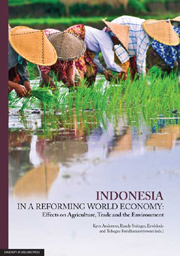Book contents
- Frontmatter
- Contents
- List of tables, figures and boxes
- FIGURES
- Acronyms
- Preface
- List of contributors
- 1 Introduction
- 2 Effects of growth, its interruption, and the Uruguay Round on Indonesian agriculture
- 3 Effects of AFTA and APEC trade policy reforms on Indonesian agriculture
- 4 Trade liberalisation and soil degradation in Indonesia
- 5 Will the Uruguay Round and APEC reforms harm air and water quality in Indonesia?
- 6 Impacts of agricultural protection growth at home and the WTO's Doha Round on Indonesian agriculture
- 7 Effects of agricultural policy reform on household and regional income distribution in Indonesia
- 8 Effects of farm policy reform on Indonesia's secondary food crops
- 9 Effects of agricultural policy reform in Indonesia on its food security and environment
- 10 Impacts of trade policy reform on income distribution and poverty in Indonesia
- APPENDIX 1 The WAYANG Model of the Indonesian economy
- APPENDIX 2 The GTAP Model and database
APPENDIX 1 - The WAYANG Model of the Indonesian economy
Published online by Cambridge University Press: 05 June 2012
- Frontmatter
- Contents
- List of tables, figures and boxes
- FIGURES
- Acronyms
- Preface
- List of contributors
- 1 Introduction
- 2 Effects of growth, its interruption, and the Uruguay Round on Indonesian agriculture
- 3 Effects of AFTA and APEC trade policy reforms on Indonesian agriculture
- 4 Trade liberalisation and soil degradation in Indonesia
- 5 Will the Uruguay Round and APEC reforms harm air and water quality in Indonesia?
- 6 Impacts of agricultural protection growth at home and the WTO's Doha Round on Indonesian agriculture
- 7 Effects of agricultural policy reform on household and regional income distribution in Indonesia
- 8 Effects of farm policy reform on Indonesia's secondary food crops
- 9 Effects of agricultural policy reform in Indonesia on its food security and environment
- 10 Impacts of trade policy reform on income distribution and poverty in Indonesia
- APPENDIX 1 The WAYANG Model of the Indonesian economy
- APPENDIX 2 The GTAP Model and database
Summary
WAYANG is a comparative static computable general equilibrium (CGE) model. It is a linearised model in the ORANI school (Dixon, Parmenter, Sutton and Vincent, 1982). However, WAYANG has been adapted to take account of some of the specific characteristics of a developing, largely agrarian economy (Warr, Marpudin, da Costa and Tharpa, 1998). As with other recent versions of models of this school, it uses an ORANI-G format in the model code, within the GEMPACK software used to solve the model (Harrison and Pearson 1994). Wittwer (1999) presents a detailed elaboration of WAYANG, adapted from Horridge, Parmenter and Pearson (1998).
There are 65 industries in WAYANG producing 65 commodities. WAYANG contains data and parameters to characterise six different sets of commodity sales. These are inputs to (1) production and (2) investment, sales to (3) households, (4) exports and (5) government, and (6) changes in stocks. In addition, the model includes details of production costs, including purchases of intermediate commodities, primary factors and other costs. WAYANG also includes a unique module capturing the distribution of incomes and expenditures between ten different households, who, by assumption, own all factors of production. The model contains a small fiscal extension and finally, a top-down regional disaggregation of the Indonesian economy. This appendix outlines the model by going through each of the above components systematically.
- Type
- Chapter
- Information
- Indonesia in a Reforming World EconomyEffects on Agriculture, Trade and the Environment, pp. 244 - 254Publisher: The University of Adelaide PressPrint publication year: 2009



